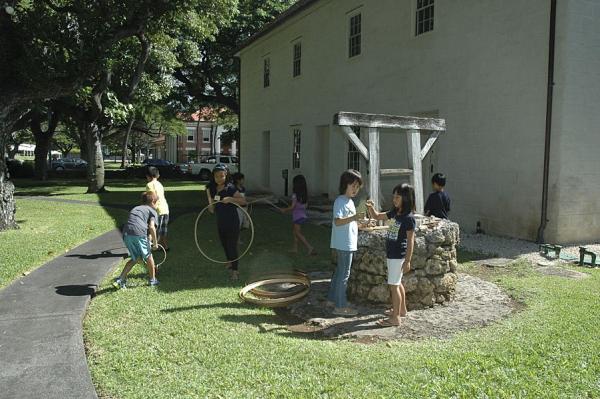50 States of Preservation: Hawaiian Mission Houses Historic Site and Archives in Honolulu, Hawaii

Traditional children’s games
Image courtesy of Hawaiian Mission Houses Historic Site and Archives

Traditional children’s games
Image courtesy of Hawaiian Mission Houses Historic Site and Archives
This feature is part of a series we call “50 States of Preservation,” in which we are touring small and mid-sized museums, libraries, historical societies, and other repositories across the country to show how they are helping to preserve the nation’s cultural heritage. Read other entries in the series here.
Based in Honolulu, the Hawaiian Mission Houses Historic Site and Archives (HMH) collects and preserves documents and artifacts that explore the role of Protestant missionaries from New England in the history of Hawai’i. It contains over 5,000 artifacts, including furniture, quilts, bark cloth, paintings, ceramics, clothing, and jewelry, most of them dating to the mission period, 1820 to 1863. HMH also holds more than 12,000 books, manuscripts, original letters, diaries, journals, illustrations, and Hawaiian church records; its collection of Hawaiian language books is the largest in the world. HMH also owns the two oldest houses in the State of Hawai’i, and the site is a National Historic Landmark. The size and scope of its collections make HMH one of the foremost repositories for 19th-century Hawaiian history. Highlights include: a damask-covered koa wood rocker handcrafted in 1830 by Reverend Hiram Bingham for Queen Ka’ahumanu, the powerful regent of Hawai’i who became one of the mission’s greatest benefactors; and Western-style garments fashioned from the bark and fibers of native plants which represent a transitional mode of dress for many Hawaiian women.
HMH’s public and educational programs focus on the collaboration between Native Hawaiians, their chiefs, and the American missionaries that resulted in, among other things, the introduction of Christianity to the Islands, the creation of the Hawaiian written language, the promulgation of the concept of constitutional government, and the evolution of new and distinctive musical traditions with harmony and choral singing. In recent years, HMH has renewed its commitment to preserve, manage, and make its collections accessible to the general public. Volunteer docents conduct tours of the historic houses, while several thousand school children visit HMH annually. A significant portion of the archival collection has been digitized, and translated, and is accessible online.
Some objects in the HMH’s collection have undergone more than a hundred years of exposure to harsh conditions. These include high humidity, vog (volcanic air pollution), and exhaust from the high traffic roads that surround the HMH property. In decades past, the object collections have also undergone various moves and reorganizations using methods which are now out of date. To address these various concerns, the HMH secured a grant in 2015 from the National Endowment for the Humanities, which supported a general needs assessment of the collection. Conservator Linda Hee evaluated the overall physical condition of the objects, including their current housing and environmental conditions. Her written report offered short-term and long-term recommendations for improvements. Supplies were also purchased to help preserve fragile textiles including a rare piece of bark cloth. Based on Ms. Hee’s assessment, HMH staff is developing a systematic plan to address a range of preservation issues including emergency preparedness, pest management, and conservation.
Some objects in the HMH’s collection have undergone more than a hundred years of exposure to harsh conditions. These include high humidity, vog (volcanic air pollution), and exhaust from the high traffic roads that surround the HMH property. In decades past, the object collections have also undergone various moves and reorganizations using methods which are now out of date. To address these various concerns, the HMH secured a grant in 2015 from the National Endowment for the Humanities, which supported a general needs assessment of the collection. Conservator Linda Hee evaluated the overall physical condition of the objects, including their current housing and environmental conditions. Her written report offered short-term and long-term recommendations for improvements. Supplies were also purchased to help preserve fragile textiles including a rare piece of bark cloth. Based on Ms. Hee’s assessment, HMH staff is developing a systematic plan to address a range of preservation issues including emergency preparedness, pest management, and conservation.
According to Elizabeth Pooloa, HMH’s Curator of Object Collections, the project also resulted in improvements in pest management: “Our consulting conservator pointed out that keeping any regular cardboard bankers boxes in our storage area in the historic house is an invitation to pests! Through the consultation and grant funding, I was able to purchase enough archival boxes to remove all unsuitable cardboard from the object areas."
In every state, NEH supports organizations that preserve humanities collections. Preservation Assistance Grants for Smaller Institutions (PAGs) fund projects that help safeguard photographs, letters, documents, prints, moving images, sound recordings, maps, drawings, artworks, textiles, furniture, and artifacts, making them available for future generations. These collections help researchers, educators, and members of the public better understand the complex stories of the various cities, towns, and tribal groups that make up our nation.
Since 2000, NEH has made nearly 2,000 Preservation Assistance Grants to small and mid-sized organizations to preserve and care for their humanities collections. In all 50 states, the District of Columbia, and Puerto Rico and the Virgin Islands, PAG awards have funded preservation assessments, purchase of shelving, environmental monitoring equipment, and preservation supplies, and training for staff. Organizations in all states and U.S. territories are eligible to apply, and the program encourages applications from those new to NEH. The next application deadline Preservation Assistance Grants for Smaller Institutions is May 1, 2018. If you have any questions about this grant program, please contact us at @email or 202-606-8570.







